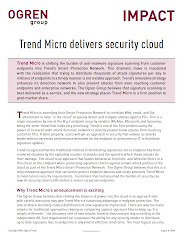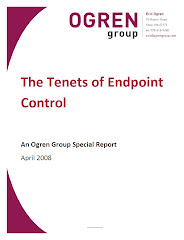Invincea is starting off what promises to be an exciting RSA
2015 with its Advanced Endpoint Protection announcement, and I am looking forward to catching up with the latest RSA ECAT, Bromium vSentry, Cybereason, and more in the endpoint security space. (Also keen on a few others, but that is for next week :). Here is something I wrote a while ago that still reflects my thinking today!:
Continuous endpoint monitoring has become a strategic
imperative for many security organizations. Modern attacks designed to extract
confidential information modify endpoint software, reconnoiter your network
looking for exploitable weaknesses, and connect to externally-sourced servers
to deliver your secrets. The inevitable result is a labor intensive
investigation to detect infected systems and a costly recovery process that
impacts the business. If you are not continuously monitoring your endpoints,
servers and connected user devices, then you will not have the intelligence to
rapidly detect attacks within your perimeter and expeditiously restore normal
business operations.
You have all invested in the latest pattern-matching cyber-security
defenses to prevent attacks from penetrating the network. Traditional
anti-malware is a required fundamental, but is proven to be incapable to
preventing threats and cleaning up after an infection. In fact, it is difficult
to determine what constitutes best-of-breed anti-malware and many of you base
purchase decisions on price and business relationships knowing that you need to
check the compliance box and that it leaves large gaps in your cyber-security
practice that you must account for.
CISOs are now expected to improve operational performance in
detecting security incidents and to reduce the time and energy required to
return infected devices to a secure state after the detection of an attack.
This strategic imperative to integrate detection of and recovery from security
events with business operations drives demands for effective monitoring of
servers and user endpoints. You will also find organizational benefits of
security utilizing endpoint intelligence to better integrate cyber-security
with IT teams.
The main features of a continuous endpoint monitoring
program include:
·
Automate
behavioral approaches to monitor changes in configurations, network usage,
memory utilization. All attacks leave traces that can be detected such as insertion
of attack logic into executable code in memory or in persistent storage,
probing of your network in search of vulnerable endpoints that can join the
attack or host confidential information that can be monetized by the intruder, communicate
with external application services and IP addresses to pilfer your electronic business information
assets. Deploy endpoint monitoring to detect unauthorized changes to your
infrastructure that may indicate the presence of an attack.
·
Use
endpoint monitoring to help you confirm changes to your security policy,
including deployment of software upgrades and patches, and retirement of
obsolete or insecure software. While endpoint monitoring solutions analyze
endpoints for the presence of infections, the process also arms you with independent
intelligence on actual software configurations. Information on where executable
programs are installed in your network can prove invaluable when it comes time
to plan and launch attack investigations and cleanup operations. You get what
you inspect, not what you expect.
·
Endpoint
monitoring, a single source of
information on software and network activity, becomes a focal point for the
integration of security with business operations. The business integration
values of a continuous endpoint monitoring program go well beyond enhancing
operational security performance for detecting cyber-threats and returning to a
compliant business. IT organizations, such as end-user service desks, application
services, network management, and quality assurance increasingly use security
monitoring technologies as a go-to source of real-time information of what is
actually happening on endpoints. They do this because endpoint monitoring
reduces errors and makes their jobs easier. You will find IT colleagues using
your endpoint monitoring solution to quickly gather the information they need
to maintain the infrastructure.
You know you need an automated system that can efficiently
and cost-effectively allow you to detect infections before your customers
report them, and accelerate recovery procedures to restore a compliant
business. Your peers in other organizations are utilizing endpoint monitoring
tools as a strategic imperative for operating a secure business. If you are not
leveraging endpoint monitoring in your security practice, this should rise to
the top of your priority list for 2015.







